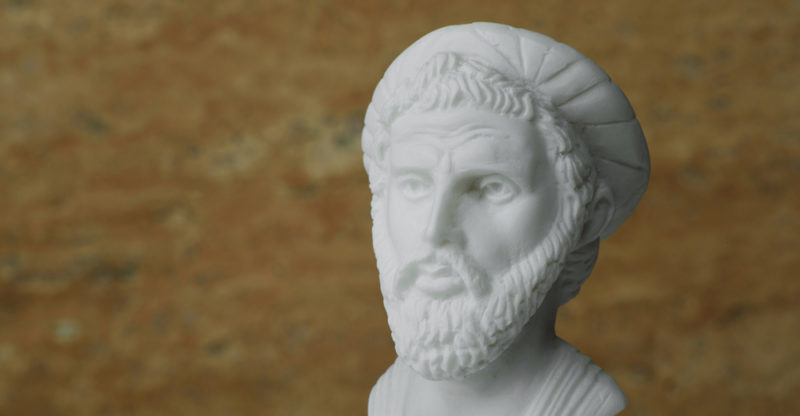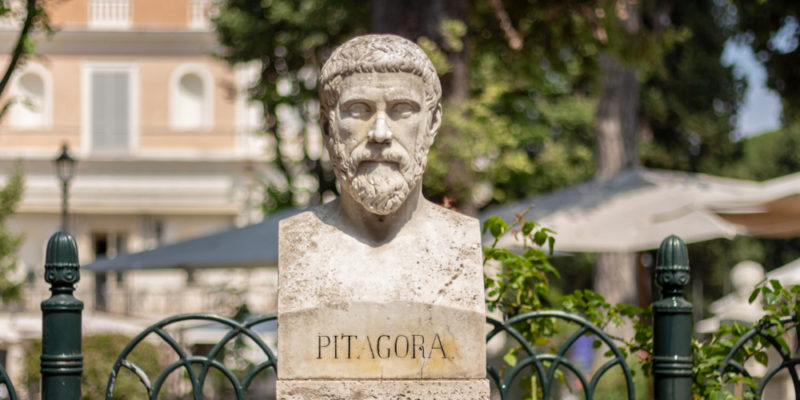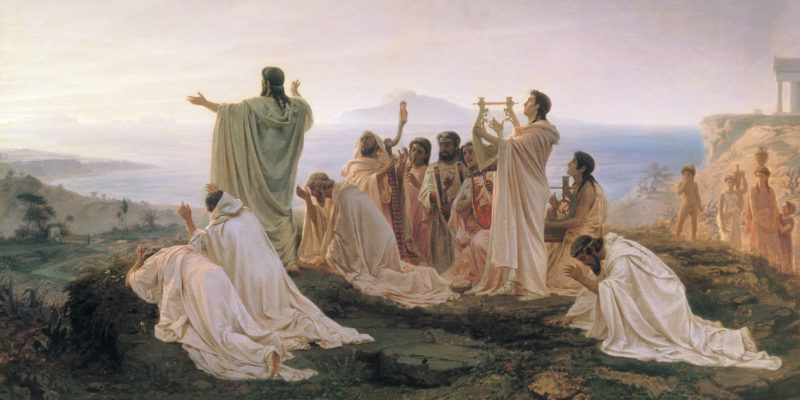We explain who Pythagoras was, his contributions and the Pythagorean brotherhood. In addition, we explore his theories and main characteristics.

Who was Pythagoras?
Pythagoras of Samos, also simply known as Pythagoras, was an Ancient Greek philosopher and mathematician known for his contributions to the advancement of Hellenistic arithmetic, geometry and mathematics and for his influence on both Plato and Aristotle.
He is considered to be the first pure mathematician, as it was this discipline that mainly (though not exclusively) occupied his interest. Some of his theorems and postulates, especially in geometry and arithmetic, have survived to the present time.
His contributions to Western thought were key and decisive though no authored text has survived, and even if it is difficult to discern his thought from that of his followers.
- See also: Socrates
Life of Pythagoras

Pythagoras was born in the Greek city of Samos, Ionia, around 569 BC. Though there is no reliable information about the dates of his life, we know from the accounts of the Greek philosopher Aristoxenus that Pythagoras left Samos at the age of forty, which is the reason he is believed to have been born around the proposed date. He allegedly died around the age of seventy or eighty.
His father was Mnesarchus, a gem-engraver, a merchant originally from the city of Tyre and his mother was a local woman named Pythais.
Pythagoras visited Egypt and Babylon, which would have provided him the opportunity to cultivate himself from a very early age: he learned to play the lyre, recite Homer and write poetry. It is believed that Polycrates gave him a letter of introduction to Pharaoh Amasis, friend and ally of the Greek tyrant.
Pythagoras emigrated to Croton in southern Italy, possibly encouraged by Democedes, a physician at the court of Polycrates. There he founded his school and had a great impact and influence on regional rulers, thinkers and even artists, mathematicians and craftsmen, being Pythagoras himself an experienced artist.
The school’s influence immediately spread to the neighboring cities. In many of them, several members of the Pythagorean community even came to hold leadership and official positions. This led to what is known as "the Cylon conspiracy", which resulted in the murder of many Pythagoreans and in Pythagoras’ exile and his subsequent refuge in the temple of the Muses in Metapontum, where he allegedly died of starvation.
Little more is known about Pythagoras' general education beyond what has been said. He is believed to have been a disciple of Chaldeans and sages of Syria. Also mentioned in major sources are Pherecydes of Syros, a quite elderly Thales of Miletus and lastly, the latter’s disciple, Anaximander. Accounts of Pythagoras’ life are filled with myths and legends, which were compiled by Neoplatonic and Neopythagorean philosophers.
The most comprehensive work on his life dates from the third century AD and was written by Diogenes Laertius and Porphyry. The Life of Pythagoras, by Iamblichus, is also a valuable text on the philosopher’s life.
Much remains unknown about the death of Pythagoras, although it presumably occurred around 532 BC, after the Pythagorean brotherhood was attacked by their political rivals. According to the most widespread account, Pythagoras would have died in the city of Metapontum, where his tomb was displayed in Roman times. He would have taken refuge in the temple of the Muses, where he had presumably hidden following the attack on his school until he died of starvation and dehydration.
The Pythagorean brotherhood

Pythagoras settled in the Italian city of Croton around the year 522 BC, after having been a prisoner of war of the Persian emperor Cambyses II, who invaded Egypt in 525 BC.
In this Italian city he founded his school, known as "the Pythagorean brotherhood", in which both men and women were admitted. They referred to themselves as "mathematicians" (matematikoi) since they believed reality is essentially mathematical in nature, and they applied and promoted the study of numbers beyond their use in commerce and political matters.
The brotherhood came to have 300 followers known as "the Pythagoreans", who owned no possessions, practiced vegetarianism and were divided between core members of the order and listeners (called "acousmatics", who did not live in the temple).
Initiates were sworn to secrecy, a source of suspicion and envy among its enemies and dissidents. Communal life was promoted and everyone who was part of it was demanded to observe strict loyalty. Asceticism and metempsychosis (the belief in the transmigration of certain psychic elements from one body to another) were common practices among its members.
Around 500 BC, the Pythagoreans assumed a certain political role in the region until they were attacked and defeated in 460 BC by their political opponents.
Pythagorean principles

Pythagoras and his disciples observed the following philosophical principles:
- Reality, in its deepest perception, is mathematical. All things are numbers.
- Philosophy can be a path to spiritual purification.
- The human soul can rise high enough to merge with the divine.
- Certain symbols of a mystical nature are considered sacred signs.
- All members of the Pythagorean brotherhood must swear to absolute secrecy regarding their beliefs and practices.
Contributions of Pythagoras

The most significant contributions of Pythagoras were:
- Philosophy. Pythagoras was the first Greek thinker to provide a non-mystical or religious explanation for the origin of all that is. His idea of a physical or natural principle, in his case water as underlying of all things, paved the way for a rational and discursive understanding of the world as we know it.
- Mathematics. Pythagoras formulated the eponymous theorem, according to which "the sum of the areas of the two squares on the legs equals the area of the square on the hypotenuse". He is also credited with the geometric construction of the first perfect solids and the discovery of perfect and amicable numbers as well as polygonal numbers. His work with triangles and the square root is a cornerstone of this discipline.
- Astronomy. He was among the first to point out that the morning and evening stars are the same planet: Venus. He also taught that the Earth was the center of the universe (geocentric model) and that the orbit of the Moon was inclined to the equator of the Earth, although these discoveries are also ascribed to Parmenides.
- Music. He is credited with the discovery of the laws of regular musical intervals and the invention of the monochord, as well as with the teaching of an ethical and medicinal use of music. From this, emerged the idea that there is a reciprocal harmony between the various systems of the universe and that in this sense, astronomy, music, health and other areas of thought are related.
Acknowledgement of Pythagoras
Beyond the eponymous theories, Pythagoras' name is honored with a lunar crater (Pythagoras) and an asteroid (6143) in the solar system.
References
- De la Fuente, H., & David, A. (2011). Vidas de Pitágoras. Atalanta.
- Guthrie, W. (1984). Historia de la filosofía griega, vol. I. Los primeros presocráticos y los pitagóricos. Gredos.
- Guthrie, W. (1953). Los filósofos griegos. De Tales a Aristóteles. FCE.
Related articles:
Was this information useful to you?
Yes NoThank you for visiting us :)